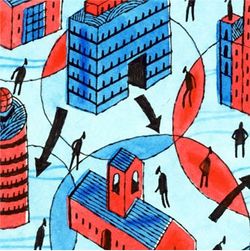
Economics addresses this basic problem: There are n agents interacting with each other in m markets. We want to find out the equilibrium set of actions of each of the agents in each of the markets as well as the associated prices and quantities. As agents and markets increase in number, the computing power required to solve this problem increases exponentially in nm, and inversely with the level of precision one wishes to achieve.
It is clear, as Rust [1] eloquently argues, that for an even moderately complex economic model, there is very little hope of actually solving the problem. This has, in fact, spawned more and more literature on impossibility theorems (also surveyed by Rust) pertaining to the computation of economic problems. One solution to this conundrum is to have agent-based models. Here, the power and intelligence of real-life markets is mimicked in the laboratory populated by agents acting in markets exactly as they are supposed to in real life. Rather than trying to compute the solution to models, we actually let the market mechanism find one for us. Again, as Rust points out, the computing power required now only increases exponentially in the number of markets, m. This route provides an acceptable theoretical alternative. This is the motivation behind the Synthetic Economy for Analysis and Simulation (SEAS) project.
SEAS is a distributed, interactive, real-time environment for conducting large-scale experiments and simulations in areas where interactions among agents need to be studied. SEAS replicates the real world in most crucial dimensions, such as competition, regulation, decision variables, and interaction dynamics. It consists of interlinked goods, stock, bond, labor, and currency markets, as the Figure in this sidebar shows. In these markets, two types of agents interact: live, that is, people acting as buyers, sellers, regulators, intermediaries; and virtual, or artificially intelligent software agents, that mimic human consumers in a narrow domain.
SEAS is a dynamically reconfigurable environment structured around the interplay of human decisions and game events that requires active involvement of participants. It helps participants understand the sources and motivations underlying the decisions by placing them in the shoes of executives running the firms in different points in time and challenging them to do better. Games dealing with current or future situations help explore the potential implications of various courses of action and raise important questions for further investigation.
A game design requires four steps: setting the geography of the game; designing the game board, pieces and scoring; customizing the database; and calibrating the artificial agents’ parameters to match that of the real consumers. SEAS simulation process consists of three steps:
- Pre-game briefing. It provides an industry overview of the players and their strategic positions and the rules of engagement.
- Game playing. Here, the participants try out their long-term strategic and short-term tactical moves, evaluate their performance periodically, and make adjustments.
- After-action review. Participants are allowed to develop strategic insight by reviewing the performance of each of the groups, analyzing the moves, countermoves and their effectiveness, and learning from collective experiences.
Several simulations and experiments have been conducted using SEAS. For details, see [2].




Join the Discussion (0)
Become a Member or Sign In to Post a Comment